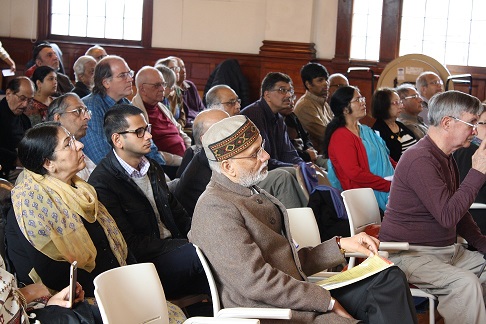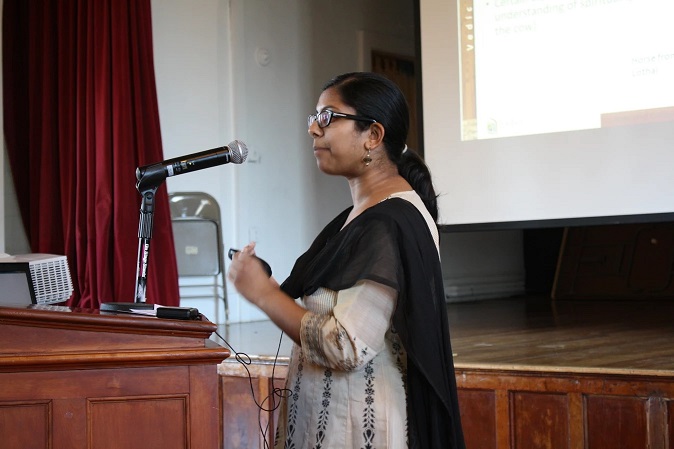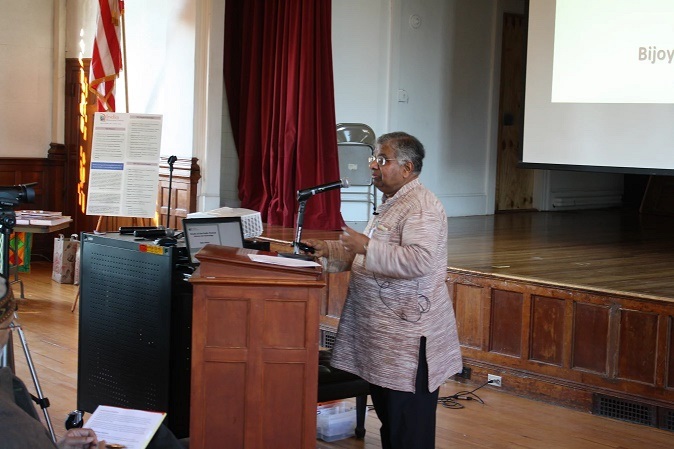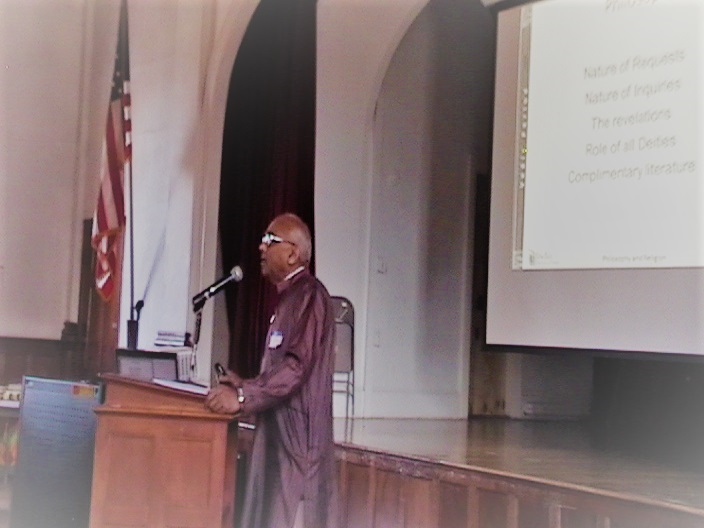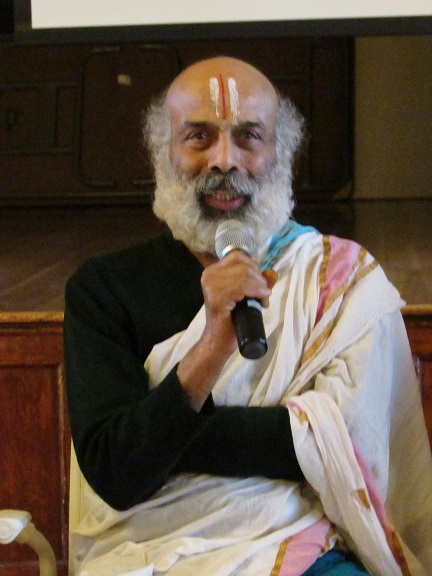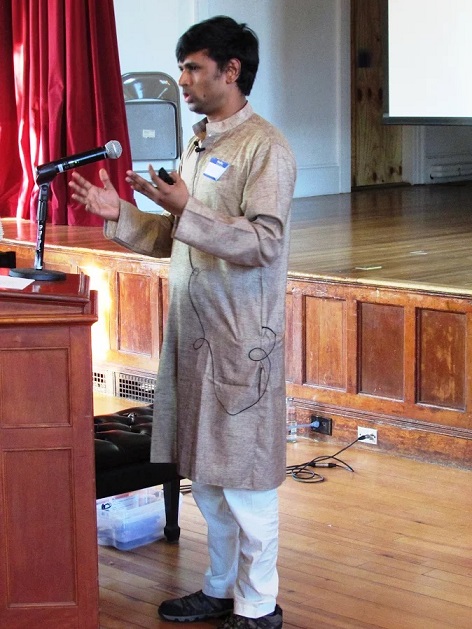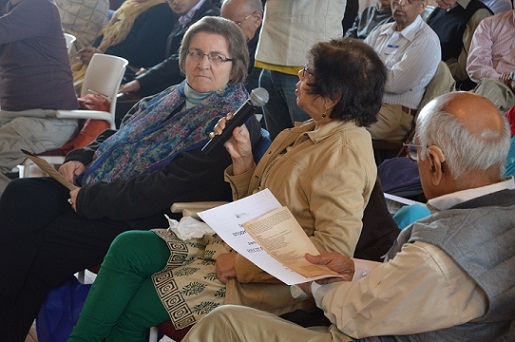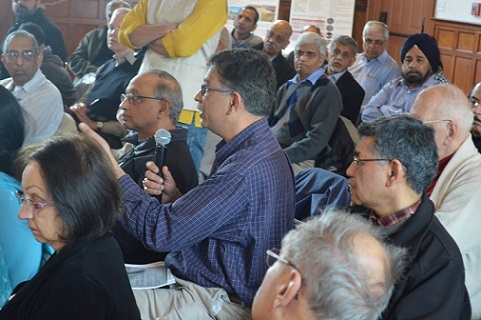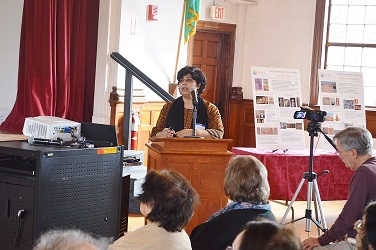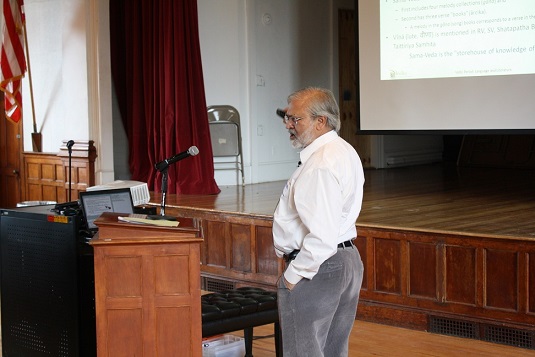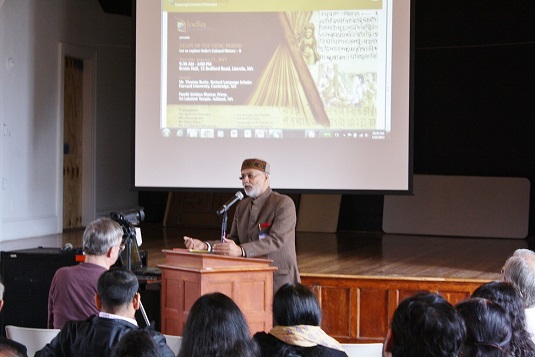Contribute
| "Language And Organization" - Two Key Contributions From The Vedic Period - Part II |
Ravi Nene
02/23/2017
The following is a summary of six presentations (i) Geography and People, (II) Language and Literature, (iii) Philosophy and Religion, (iv) Art and Culture, (v) Science and Technology and (vi) Economy and Politics from the “Seminar of the Vedic Period”, organized by India Discovery Center, on January 21, 2017, in Bemis Hall, Lincoln, MA.
(Visit https://lokvani.com/lokvani/admin/articleEdit.php?article_id=13061 for Part I of the report)
Geography and People
The first lecture on Geography & People was given by Ms. Reshma Ghanekar. This talk was a testimony to the interest and inquisitiveness shown in exploring the as yet unknown areas of Vedic period using traditional methods as well as novel and modern techniques of investigation.
The extent of the spread of population can be gaged from geographical references in Rgveda and other texts. References to Saraswati river are in abundance in these texts. By the time of the Mahabharata, the entire sub-continent was populated.
Geologic studies as well as studies based on evaluation of human remains (such as teeth and bone) using oxygen isotopes have been helpful in understanding climate change. Climate variation from arid regions to fertile regions, going from West to East seems to have developed by 2100 BC. Several archeological sites give insight into continuous habitation of regions around the banks of Saraswati river. This evidence has been accumulating for the past two hundred years.
The modern investigative technique uses tools provided by Y chromosomal DNA and Mitochondrial DNA for figuring out the origins of the people. According to this research, the current Indian population descends from just 4 Y-DNA clusters, viz. ANI, ASI, AAA and ATB. The mtDNA is pretty much uniform across India. The research does not suggest any external incursion in the last forty thousand years.
Ms. Ghanekar ended her presentation by describing the social structure of those early years and the life of people that was governed by the belief that the eternal truth was revealed through the Vedas.
Language and Literature
The second lecture on the track about Language & Literature was given by Mr. Prem Nagar. He explained in great detail the genesis of the Vedic era literature and its evolution as time progressed.
Mr. Nagar started with explaining what Vedas are and the relationship of the four basic Vedas (Samhitaas) to other Vedic literature – like Brahmanas, Aranyakas and Upnishads. He briefly noted that Vedic literature does not have any references to population movements. Numerous references to river Saraswati suggest that the settlements around this river might be the place where the Vedic people lived.
Mr. Nagar then did a deep dive into the Vedic language, various words in it that may be common to other local languages; adoption of words from other languages into Vedic language. He also pointed out that challenges still remain regarding understanding of many words and their relationship with language of Avesta and other contemporary languages of Hittites and Mitannis. Mr. Nagar also discussed the “dhatu” (verb) based word development.
The structure and characteristics of Vedic languages were explained in a methodical way. Using Chhand and construction of grammatical structures and rules was a brilliant innovation. Since writing was non-existent it was essential to come up with a language architecture and system that could preserve the contents indefinitely without getting corrupted.
The next area addressed by Mr. Nagar was the contents and specialties of the four Vedas. Considering the time when the Vedas were created, it is astonishing to know how many topics are covered by these texts - from discussing cosmic principles to the practices in everyday life. He stated that overall three hundred and forty-seven families appear to be associated towards the composition.
Mr. Nagar concluded his wonderful lecture by explaining the six disciplines of Vedanga. Study of Vedanga became essential in order to study and fully master the Vedic texts.
Philosophy and Religion
Mr. Vrittamani Rampriya elucidated the Philosophy and Religion of the Vedic period. He started with explaining the nature of Requests and Inquiries in Vedas. He gave examples of the requests – for example, asking for good health and nourishing food, removing sin from life. Example of inquiries include questions like how do I get clarity of thought, how is consciousness endowed to the body made of flesh and blood? These inquiries relate to number of subjects – humans, animals, plants, divine guidance etc.
These requests and inquiries became the part of the Vedic philosophy. The philosophical nuggets are spread in almost all the Vedic texts. For example, the Shatapath Brahmana says: the one who knows that the Vedi (the platform where the Earth and the Space are united) and the Parabrahma are one and the same, will rule over the entire earth and will achieve oneness with Agni. Generally, the philosophy is expressed as the Eternal Religion or Sanatana Dharma in the modern terminology.
The part of this lecture that explains Vedic Religion, goes into elucidating Vedic Rituals, Mantras, Hymns and Prayers, among other things. Rituals are an important part of the religion. Yajurveda defined the procedure of a ritual. This led to define the duties of a Yajaman, Hotru, Adhvaryu, Udgatru, Brahma – the presiding priest of a Yajnya and finally that of the Ritvik. A Sukta, the basic unit of addressing the divinities had a discipline of utterance taught by a Stotri. The sukta consisted of many mantras. A Prayer, consisting of many Suktas, asked the divinities to grant the wishes of the devotee.
Art and Culture
The remaining three tracks were presented following the lunch. Ms. Paromita De, on the Art & Culture of the Vedas, explained the purpose of her endeavor in exploring the creativity and social structures of Vedic period. She investigated Craftsmanship, Ritualistic Arts, Performing Arts, Visual Arts and Literary Arts of the period.
Crafts involved making statues, figurines using tools like blades, stones, sickles, arrowheads etc. Specimens of visual arts consisted of garments for men and women made from cotton, silk and gold and copper jewelry. Visual arts played a role in the design of homes and the materials used in the construction of homes, viz, mud, brick, limestone etc.
Ms. De describes rituals as part of the Literary Art. The rituals involve recitation of Shlokas, Storytelling, and Chanting of Mantras. The rituals involved Pujas, decorating animals for sacrifice. The sacrificial pyre also had its own design and artistic presentation.
Performing arts includes vocal artists and performances with musical instruments like the drums, flute and Veena. The music, musicians and their instruments became part of the dramatic presentations that had spiritual content. They also had artistic performances offered for fertility.
All the arts described above became part of the Vedic Culture where use of language honed one’s identity, relationship and conduct. Ms. De’s research shows that the status of women in those days was equal to the status of men, except when it came to property rights. She did not find any evidence of caste system, but found that servants were used in household affairs. Polygamy was practiced as it was in other contemporary societies of the world.
Science and Technology
Dr. Bijoy Misra gave the presentation on Science and Technology. The sciences covered were Cosmology, Astronomy, Mathematics, Medicine, Meteorology, Hydrology, Science of Speech, Communication, Phonetics and Mind. And the technology topics alluded were Chemical Technology, Tools, Transportation, Housing Construction, Food Preparation, Agriculture, Voice technology, Medical technology, Model of Life and Home organization.
Cosmology was of utmost importance to the Vedic people as it joined the universe with the soul and mind. The order “Rta” formed the basis of their philosophy. This philosophy described what is “sat” and what is “asat”. It explained how material universe evolved through a series of progressive steps that traverse from the “sky” to the living objects used as “food”.
The mind moves naturally from ideas of Cosmology to the facts made visible by Astronomy. This resulted in theories of three physical layers, the earth, the atmosphere and the radiant outer space. Metaphysical powers were assigned to the layers for their functionality on human life. Sun was considered the sustainer of life, and the regulator of time. It was worshipped as the sole cause. Meters were invented to communicate to the forces in different layers assuming an animated universe.
Mathematics was important to create the proper dimensions of the sacrificial pyre mapping the sky into the local domain. Geometry was employed and large numbers were freely used. Concept of decimals appears to be known. No numerical symbols have been found.
Vedic period witnessed the beginning of philosophical concepts related to mind. The physical senses like speech, hearing, touch, life were logically connected to non-sensory ideas about mind, joy, sorrow, knowledge etc. This led to the development of the health sciences as a therapy to general well-being. Detailed classifications of body-features, tissues and bones were made. There developed extensive knowledge of medicinal uses of herbs.
Speech was decomposed into four stages of production, three latent and one audible. Research on the latent stages conceived by the Vedic scientists are now being verified by modern investigations in neuroscience. Dr. Misra cited their paper on the topic presented to World Sanskrit Conference at Bangkok in 2015.
Various chemical and mechanical technologies were in use in everyday life. Grinding, mixing, boiling and distilling were among some of the chemical technologies. Food preparation like cooking, making dairy derivatives like yogurt and ghee became part of daily activity for sustenance of body. Tools were developed to help in almost every aspect of life like ploughing the land, building a shelter, making weapons, applying in surgery. Carts and chariots were designed and used for transportation.
Economy and Politics
The sixth and the last track was presented by Mr. Raghavendra Sarangapurkar on the Economy & Politics of the period. He also talked about social issues.
The economy of the Vedic period was driven mainly by three factors: agriculture, trades and services. Production of food was very important and was of high economic value. Many types of grains were produced. Trades like blacksmiths and goldsmiths were parts of the wheels of the economy, so were other professions like physicians and priests. Rudimentary industrial professions like mining of metals, construction of houses, vehicles, weapons, jewelry did appear. Rgveda classified the labor activity while Yajurveda talked about skilled and unskilled labor. Animals, Food and Metals were used as the equivalent of currency.
Economic activities were also generated by social functions like “Upnayana” or performance of a “Yajna”. Social norms dictated to honor a guest or perform traditional rituals. Atharvaveda mentioned that women should choose their husbands. Men and women had equal rights. People lived in joint families. On the political side, a structural hierarchy existed for governance, with the King at the top. Population centers were organized starting at the village level and culminating in Rajya.
You may also access this article through our web-site http://www.lokvani.com/
